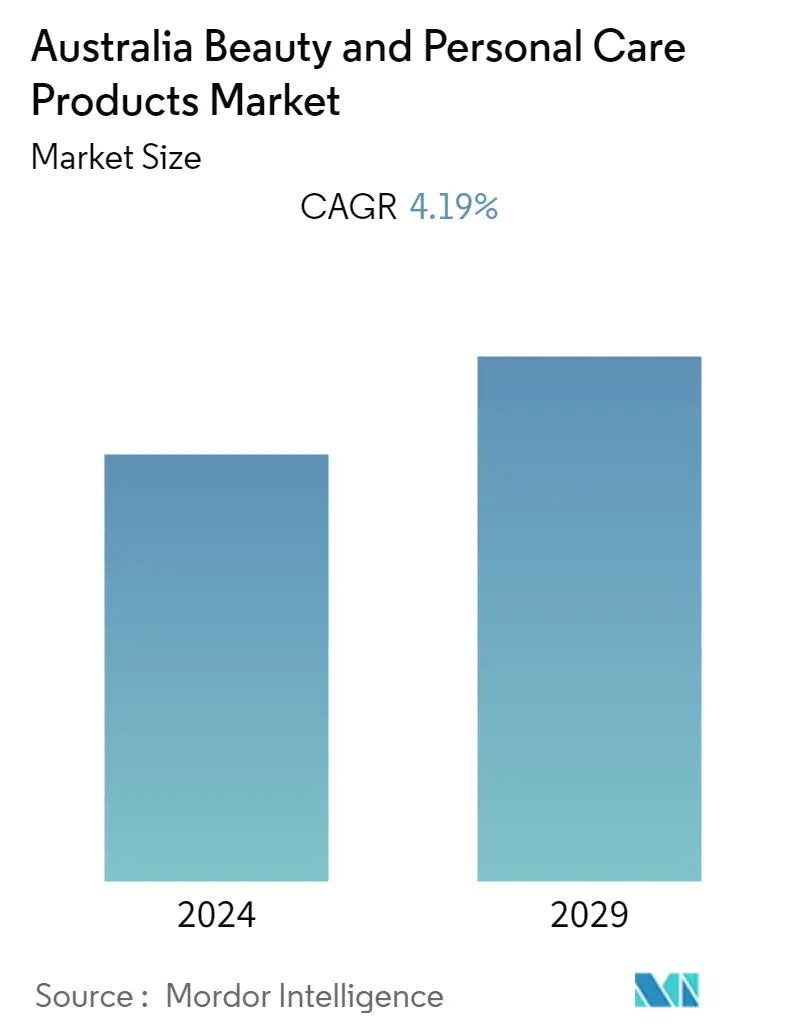
| Study Period | 2019 - 2029 |
| Base Year For Estimation | 2023 |
| Forecast Data Period | 2024 - 2029 |
| Historical Data Period | 2019 - 2022 |
| CAGR | 4.19 % |
| Market Concentration | Low |
Major Players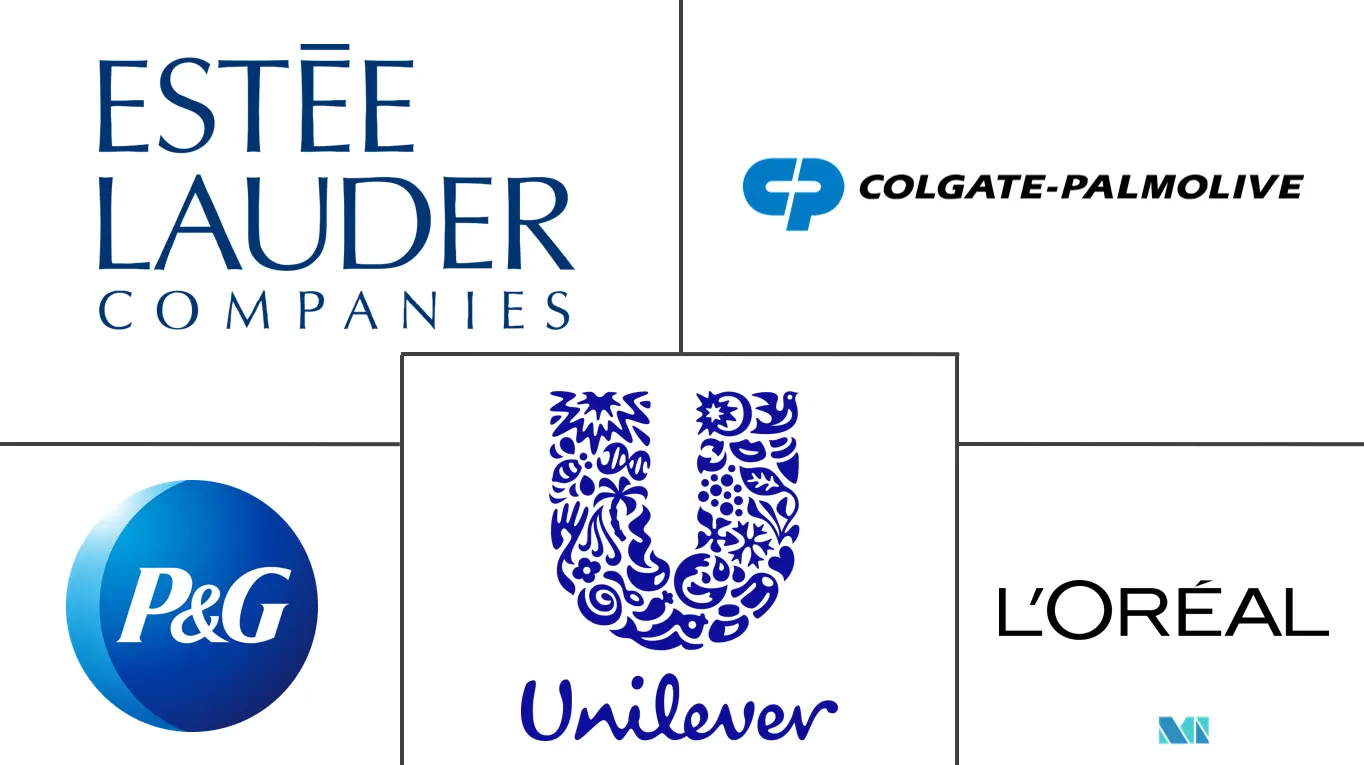
*Disclaimer: Major Players sorted in no particular order |
Australia Beauty & Personal Care Products Market Analysis
The Australia beauty and personal care products market size is expected to grow from USD 4.32 billion in 2023 to USD 5.30 billion by 2028, at a CAGR of 4.19% during the forecast period.
- Australia's beauty and personal care industry is thriving and is one of the fastest-growing consumer markets, driven by increased per capita spending on cosmetics and skin care products. The primary reasons for the growth are the high disposable income and the increased awareness among individuals about personal grooming and hygiene.
- Moreover, there has been a generational shift in recent years with young consumers entering the market. This change is reinforced by social media, internationality, and e-commerce channels, which have a lasting effect on consumers' buying behavior regarding beauty products. Additionally, companies are indulging in aggressive social media marketing to expand their consumer base and boost their overall sales revenue, influencing the market positively.
- As consumers become cautious of potential toxicity in cosmetics, market segments offering products manufactured using natural and organic ingredients and essential oils will likely report strong growth. Additionally, consumers are becoming more aware of the impacts of their beauty decisions on the environment, thus shifting to sustainable products. This trend is also reflected in various initiatives such as certifications, eco-friendly products, and recyclable packaging.
- A survey conducted by Consumer Policy Research Centre in 2022 revealed that over 25 percent of Australian consumers considered having sustainable products available in the beauty and personal care sector as very important. Therefore, companies focus on capitalizing on consumers' demand by offering products with premium botanical ingredients and multi-functional properties.
- For instance, in 2022, Skin Proud was launched in Australia, which offers products formulated with natural extracts such as pomegranate, raspberry, coconut oil, and rose water. The company claims these products to be vegan, PETA-approved cruelty-free.
Australia Beauty & Personal Care Products Market Trends
Inclination Towards Natural and Organic Formulations
- In recent years, consumers have become increasingly aware of synthetic chemicals used in cosmetic formulations and their potential side effects that lead to various health issues like skin irritation, allergies, dullness, and toxicity. Hence, there has been an enhanced demand for natural and organic beauty and personal care products nationwide. Cosmetic products made of organic and natural ingredients do not negatively impact the skin and hence are remarkably demanded.
- A survey conducted by Consumer Policy Research Centre in 2022 revealed that over 25 percent of Australian consumers considered having sustainable products available in the beauty and personal care sector as very important. Besides this, increased penetration of the internet and smartphones and social media impact, especially among the young population, driving the sales of beauty and personal care products through e-commerce channels as they provide consumers with a wide selection of innovative products.
- According to the Australian Communications and Media Authority, as of 2021, approximately 99% of Australians have internet access. According to the IAB Australia and Pureprofile Australian E-commerce Report 2021, 76% of the customers bought products online at least once a month. Among those customers, 70% bought non-grocery items, including beauty and personal care products, online every month.
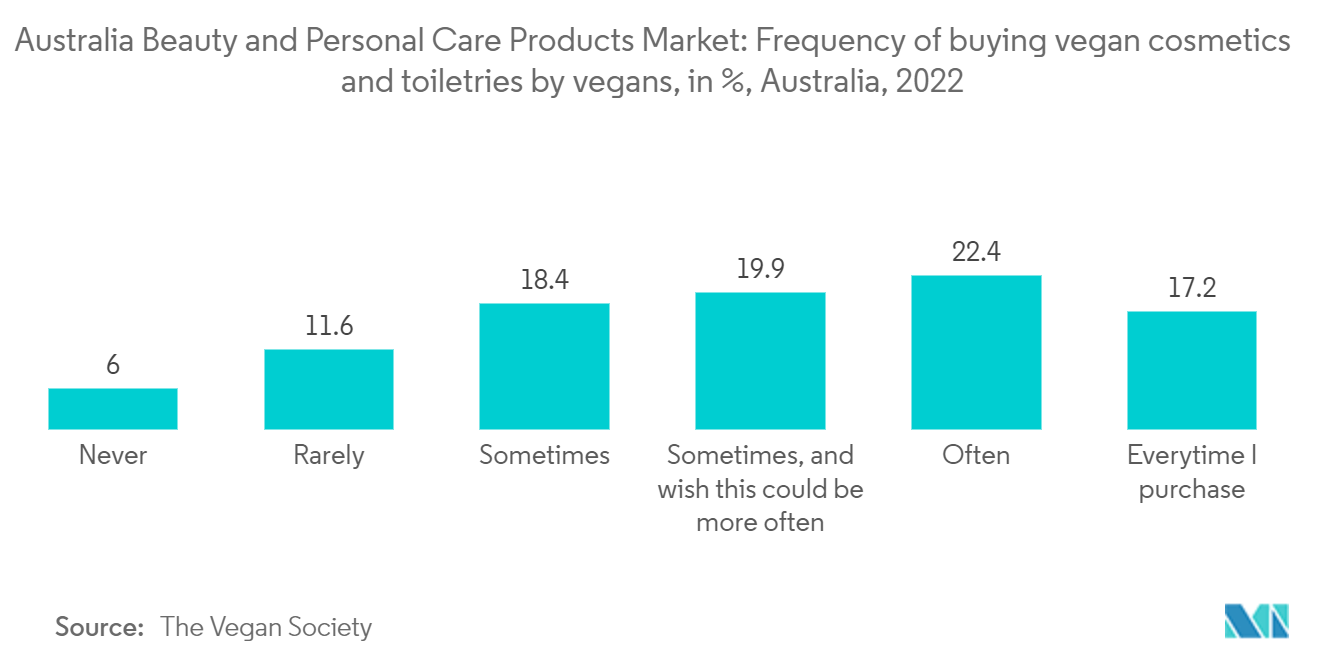
Personal Care Segment Witnesses High Growth
- People in Australia are highly involved in outdoor sports and activities, such as beach cricket, rock climbing, abseiling, skydiving, bungee jumping, and hiking. Such an active lifestyle and high environmental exposure drive the need for personal care products, such as sun care, for maximum skin protection.
- Moreover, due to the rising prevalence of hair thinning, loss of volume, dryness, and several other hair-related concerns, hair care products are emerging as the most affluent and cost-effective ways. The increasing focus on personal grooming and the rising number of hair salons boost the growth of the haircare segment in the beauty and personal care market.
- According to a survey by the Australian Bureau of Statistics, in 2019, around 73.3 thousand people were employed as hairdressers across Australia. This number was forecasted to jump to 79.6 thousand by 2024, indicating continued growth in the haircare segment. Furthermore, increasing celebrity endorsements and rising knowledge about the detrimental effects of chemicals and synthetic ingredients, as well as convenience of use and availability of tiny travel-size packs, drive demand for natural/organic and vegan hair care products like shampoo.
- Additionally, in a period where personalization and customization of skincare to meet individual consumer needs is of rising importance, products with multifunctional claims are witnessing immense popularity among consumers-players operating in the market focus on developing products with multifunctional properties to cater to the growing demand.
- For instance, sunscreen specialist Supergoop offers an SPF 40 sunscreen-serum hybrid formulated with vitamin C and hyaluronic acid in Australia. Supergoop's Daily Dose of Vitamin C + SPF 40 is a multi-tasking product that shields against UVA and UVB rays and provides the benefits of niacinamide, antioxidant-rich Kakadu plum, and Pseudoalteromonas ferment extract, a strain of healthy bacteria that encourages collagen production and helps fight the effects of blue light on the skin.
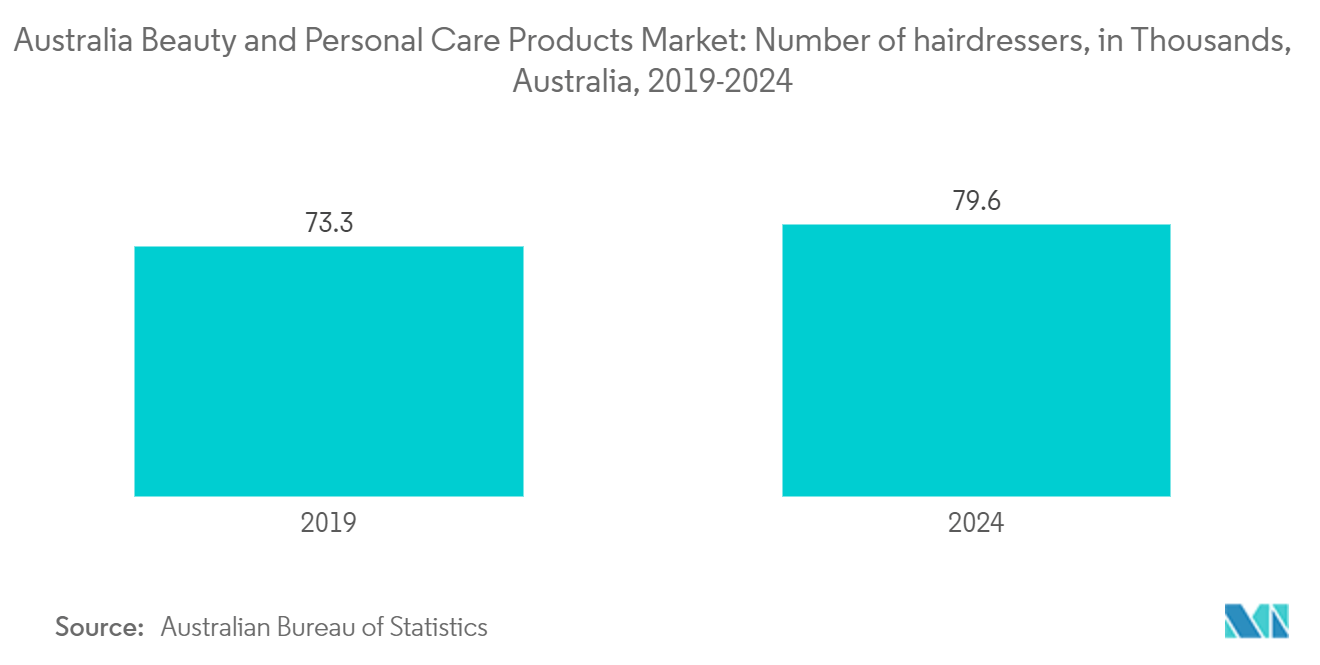
Australia Beauty & Personal Care Products Industry Overview
The Australian beauty and personal care products market is fragmented, with the presence of several companies offering their products in the market at competitive prices. Loreal SA and Unilever PLC are the top companies with a diversified product portfolio and a strong brand image.
Mergers and acquisitions characterized Australia's beauty and personal care industry as companies emphasize business consolidation to expand their share in the market. Some other prominent players operating in the market are Procter & Gamble Company, Colgate-Palmolive, and Estée Lauder Inc.
Australia Beauty & Personal Care Products Market Leaders
-
Colgate-Palmolive Company
-
Unilever PLC
-
L'Oréal S.A.
-
Procter & Gamble Company
-
The Estée Lauder Companies Inc.
- *Disclaimer: Major Players sorted in no particular order
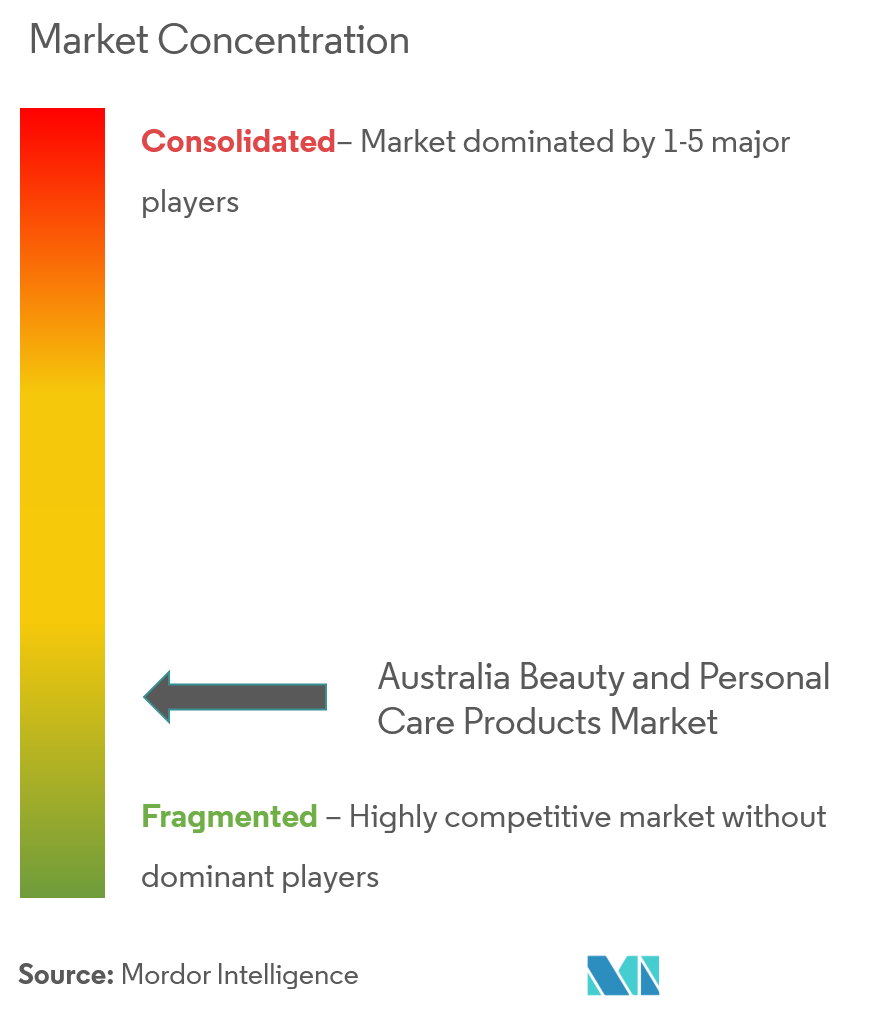
Australia Beauty & Personal Care Products Market News
- September 2022: Estee Lauder and BALMAIN entered into a partnership to launch BALMAIN BEAUTY, a line of luxury beauty products. Under the agreement, the companies aim to develop, produce and distribute a product line that appeals to affluent consumers worldwide, including Australia.
- June 2022: Shiseido, a Japanese cosmetics company, introduced Sidekick, a new range of skincare products for men. The range, which consists of four products and eight inventory items, is intended primarily for the Asian market.
- February 2021: G&M Cosmetics from Australia planned to expand its vegan beauty and baby care product range. The company moved into the vegan beauty space after acquiring P'URE Papayacare skincare in 2019. Since then, it has extended the brand to 15 vegan-approved and certified products.
Australia Beauty & Personal Care Products Industry Segmentation
Beauty and personal care products generally belong to hygiene practices and rinse off immediately after use. These products encompass cosmetics, haircare, skincare, and cleaning products.
The Australian beauty and personal care products market report is segmented based on product type and distribution channel. The segmentation based on product type includes personal care products and cosmetics/make-up products. The personal care market is further segmented into hair care products (shampoo, conditioner, and other hair care products), skincare products (facial care products, body care products, and lip care products), bath and shower (shower gels, soaps, and other bath and shower products), oral care (toothbrushes, toothpaste, mouthwashes and rinses, and other oral care products), men's grooming products, and deodorants and antiperspirants. The cosmetics/make-up products market is segmented into facial cosmetics, eye cosmetics, lip and nail make-up products, and hairstyling and coloring products. By distribution channel, the market is segmented into specialist stores, supermarkets/hypermarkets, convenience stores, online retail channels, and other distribution channels.
The market sizing has been done in value terms in USD for all the above-mentioned segments.
| Product Type | Personal Care Products | Hair Care Products | Shampoo |
| Conditioner | |||
| Other Hair Care Products | |||
| Product Type | Personal Care Products | Skin Care Products | Facial Care Products |
| Body Care Products | |||
| Lip Care Products | |||
| Product Type | Personal Care Products | Bath and Shower | Shower Gels |
| Soaps | |||
| Other Bath and Shower Products | |||
| Product Type | Personal Care Products | Oral Care | Toothbrushes |
| Toothpaste | |||
| Mouthwashes and Rinses | |||
| Other Oral Care Products | |||
| Product Type | Personal Care Products | Men's Grooming Products | |
| Deodorants and Antiperspirants | |||
| Product Type | Cosmetics/Make-up Products | Facial Cosmetics | |
| Eye Cosmetic Products | |||
| Lip and Nail Make-up Products | |||
| Hair Styling and Coloring Products | |||
| Distribution Channel | Specialist Stores | ||
| Supermarkets/Hypermarkets | |||
| Convenience Stores | |||
| Online Retail Channels | |||
| Other Distribution Channels |
Australia Beauty & Personal Care Products Market Research FAQs
What is the current Australia Beauty and Personal Care Products Market size?
The Australia Beauty and Personal Care Products Market is projected to register a CAGR of 4.19% during the forecast period (2024-2029)
Who are the key players in Australia Beauty and Personal Care Products Market?
Colgate-Palmolive Company, Unilever PLC, L'Oréal S.A., Procter & Gamble Company and The Estée Lauder Companies Inc. are the major companies operating in the Australia Beauty and Personal Care Products Market.
What years does this Australia Beauty and Personal Care Products Market cover?
The report covers the Australia Beauty and Personal Care Products Market historical market size for years: 2019, 2020, 2021, 2022 and 2023. The report also forecasts the Australia Beauty and Personal Care Products Market size for years: 2024, 2025, 2026, 2027, 2028 and 2029.
What are the growth opportunities in the Australia Beauty and Personal Care Market?
The growth opportunities in the Australia Beauty and Personal Care Market are a) Growing interest in men's personal care products can be a potential market segment for expansion b) Consumers are willing to pay more for high-quality, effective products that offer additional benefits beyond basic care
Our Best Selling Reports
Australian Beauty Products Industry Report
The Australian beauty and personal care market has experienced vigorous growth, driven by increased disposable income, enhanced personal grooming awareness, and the influence of digital platforms. Covering diverse segments such as skincare, hair care, cosmetics, and personal hygiene, the market caters to various consumer preferences with advancements in product formulations and a strong online retail presence. The shift towards natural and organic products highlights a commitment to sustainability. The men's grooming area is expanding rapidly, alongside the popularity of sun care and multifunctional products suited to Australia's active lifestyle and unique climate. Intense competition among domestic and international players fuels innovation and market penetration. For detailed Australian beauty industry statistics and insights into this dynamic market's future, referencing industry reports can offer valuable forecasts and a deeper understanding of trends within the Australian beauty industry.




